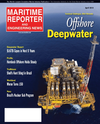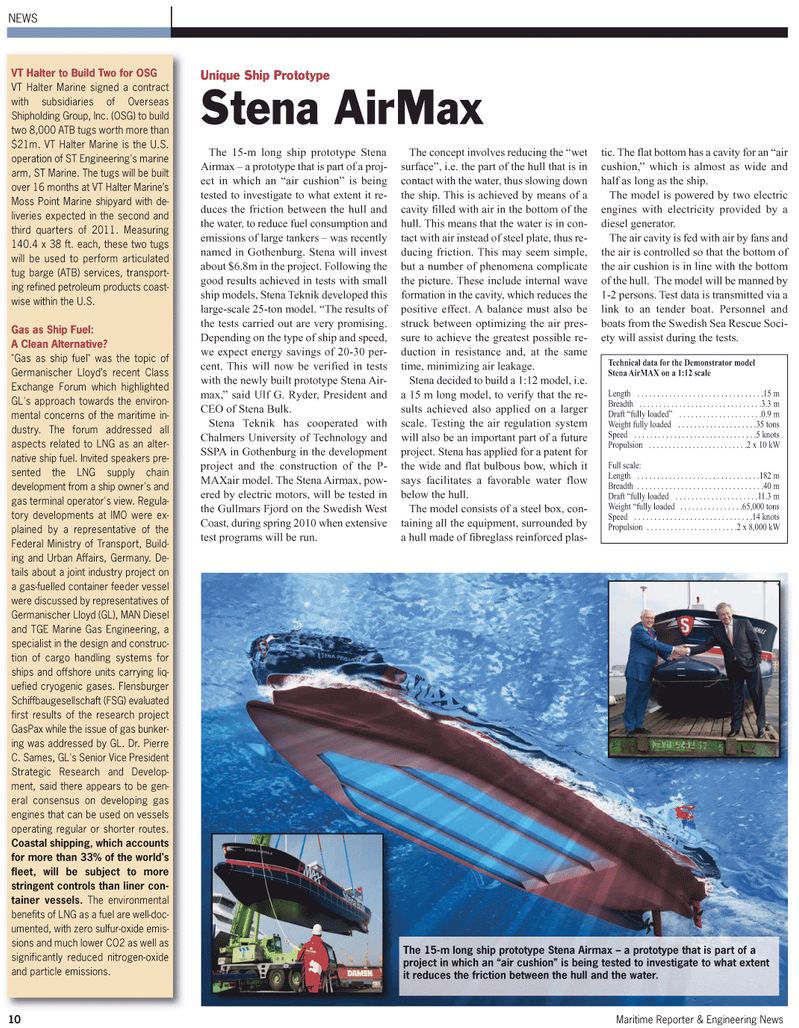
Page 10: of Maritime Reporter Magazine (April 2, 2010)
Read this page in Pdf, Flash or Html5 edition of April 2, 2010 Maritime Reporter Magazine
The 15-m long ship prototype Stena
Airmax – a prototype that is part of a proj- ect in which an “air cushion” is being tested to investigate to what extent it re- duces the friction between the hull and the water, to reduce fuel consumption and emissions of large tankers – was recently named in Gothenburg. Stena will invest about $6.8m in the project. Following the good results achieved in tests with small ship models, Stena Teknik developed this large-scale 25-ton model. “The results of the tests carried out are very promising.
Depending on the type of ship and speed, we expect energy savings of 20-30 per- cent. This will now be verified in tests with the newly built prototype Stena Air- max,” said Ulf G. Ryder, President and
CEO of Stena Bulk.
Stena Teknik has cooperated with
Chalmers University of Technology and
SSPA in Gothenburg in the development project and the construction of the P-
MAXair model. The Stena Airmax, pow- ered by electric motors, will be tested in the Gullmars Fjord on the Swedish West
Coast, during spring 2010 when extensive test programs will be run.
The concept involves reducing the “wet surface”, i.e. the part of the hull that is in contact with the water, thus slowing down the ship. This is achieved by means of a cavity filled with air in the bottom of the hull. This means that the water is in con- tact with air instead of steel plate, thus re- ducing friction. This may seem simple, but a number of phenomena complicate the picture. These include internal wave formation in the cavity, which reduces the positive effect. A balance must also be struck between optimizing the air pres- sure to achieve the greatest possible re- duction in resistance and, at the same time, minimizing air leakage.
Stena decided to build a 1:12 model, i.e. a 15 m long model, to verify that the re- sults achieved also applied on a larger scale. Testing the air regulation system will also be an important part of a future project. Stena has applied for a patent for the wide and flat bulbous bow, which it says facilitates a favorable water flow below the hull.
The model consists of a steel box, con- taining all the equipment, surrounded by a hull made of fibreglass reinforced plas- tic. The flat bottom has a cavity for an “air cushion,” which is almost as wide and half as long as the ship.
The model is powered by two electric engines with electricity provided by a diesel generator.
The air cavity is fed with air by fans and the air is controlled so that the bottom of the air cushion is in line with the bottom of the hull. The model will be manned by 1-2 persons. Test data is transmitted via a link to an tender boat. Personnel and boats from the Swedish Sea Rescue Soci- ety will assist during the tests.
Technical data for the Demonstrator model
Stena AirMAX on a 1:12 scale
Length . . . . . . . . . . . . . . . . . . . . . . . . . . . . . . . .15 m
Breadth . . . . . . . . . . . . . . . . . . . . . . . . . . . . . . .3.3 m
Draft “fully loaded” . . . . . . . . . . . . . . . . . . . . .0.9 m
Weight fully loaded . . . . . . . . . . . . . . . . . . . .35 tons
Speed . . . . . . . . . . . . . . . . . . . . . . . . . . . . . . .5 knots
Propulsion . . . . . . . . . . . . . . . . . . . . . . . . .2 x 10 kW
Full scale:
Length . . . . . . . . . . . . . . . . . . . . . . . . . . . . . . .182 m
Breadth . . . . . . . . . . . . . . . . . . . . . . . . . . . . . . . .40 m
Draft “fully loaded . . . . . . . . . . . . . . . . . . . . .11.3 m
Weight “fully loaded . . . . . . . . . . . . . . . .65,000 tons
Speed . . . . . . . . . . . . . . . . . . . . . . . . . . . . . .14 knots
Propulsion . . . . . . . . . . . . . . . . . . . . . . .2 x 8,000 kW 10 Maritime Reporter & Engineering News
NEWS
VT Halter to Build Two for OSG
VT Halter Marine signed a contract with subsidiaries of Overseas
Shipholding Group, Inc. (OSG) to build two 8,000 ATB tugs worth more than $21m. VT Halter Marine is the U.S. operation of ST Engineering's marine arm, ST Marine. The tugs will be built over 16 months at VT Halter Marine’s
Moss Point Marine shipyard with de- liveries expected in the second and third quarters of 2011. Measuring 140.4 x 38 ft. each, these two tugs will be used to perform articulated tug barge (ATB) services, transport- ing refined petroleum products coast- wise within the U.S.
Gas as Ship Fuel:
A Clean Alternative? "Gas as ship fuel" was the topic of
Germanischer Lloyd’s recent Class
Exchange Forum which highlighted
GL's approach towards the environ- mental concerns of the maritime in- dustry. The forum addressed all aspects related to LNG as an alter- native ship fuel. Invited speakers pre- sented the LNG supply chain development from a ship owner's and gas terminal operator's view. Regula- tory developments at IMO were ex- plained by a representative of the
Federal Ministry of Transport, Build- ing and Urban Affairs, Germany. De- tails about a joint industry project on a gas-fuelled container feeder vessel were discussed by representatives of
Germanischer Lloyd (GL), MAN Diesel and TGE Marine Gas Engineering, a specialist in the design and construc- tion of cargo handling systems for ships and offshore units carrying liq- uefied cryogenic gases. Flensburger
Schiffbaugesellschaft (FSG) evaluated first results of the research project
GasPax while the issue of gas bunker- ing was addressed by GL. Dr. Pierre
C. Sames, GL's Senior Vice President
Strategic Research and Develop- ment, said there appears to be gen- eral consensus on developing gas engines that can be used on vessels operating regular or shorter routes.
Coastal shipping, which accounts for more than 33% of the world's fleet, will be subject to more stringent controls than liner con- tainer vessels. The environmental benefits of LNG as a fuel are well-doc- umented, with zero sulfur-oxide emis- sions and much lower CO2 as well as significantly reduced nitrogen-oxide and particle emissions.
Unique Ship Prototype
Stena AirMax
The 15-m long ship prototype Stena Airmax – a prototype that is part of a project in which an “air cushion” is being tested to investigate to what extent it reduces the friction between the hull and the water.

 9
9

 11
11
